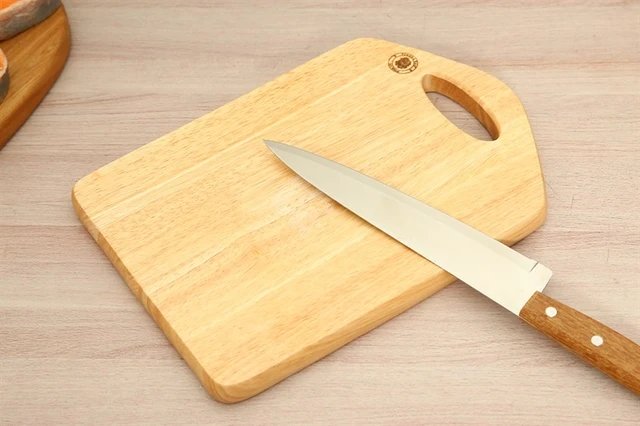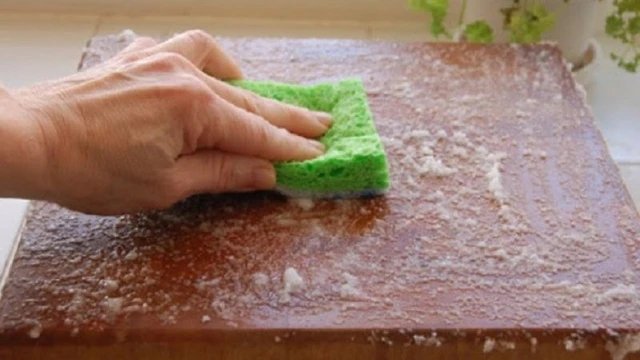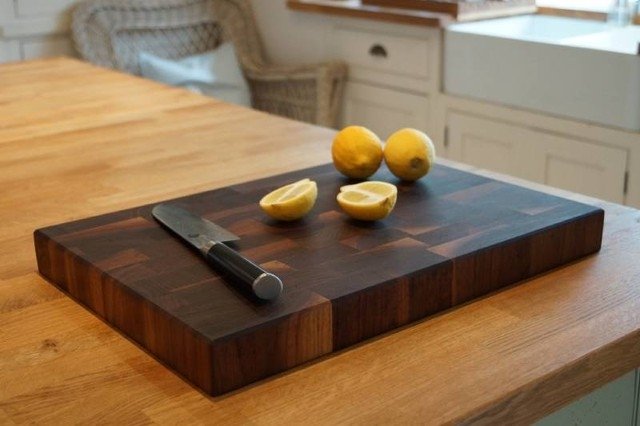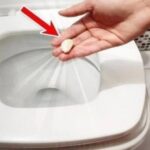Soak in Saltwater Immediately After Purchase
As soon as you get your new wooden cutting board, soak it in a solution of salt and water, using a ratio of 200g of salt per liter of water. Leave it to soak overnight, and then let it air dry.
Soaking the cutting board in saltwater helps clean its surface and ensures it has the right amount of moisture. This prevents excessive water absorption and cracking during use.

Avoid keeping the cutting board in a dry, hot environment, and direct sunlight.
After soaking, air-dry the cutting board in a well-ventilated area. This prevents mold and cracks from forming.
Store the Cutting Board in a Dry and Ventilated Area
When not in frequent use, wrap the wooden cutting board in plastic and store it in a cool, dry place away from direct sunlight. This helps maintain the necessary moisture levels and prevents cracking and damage.
If you use your wooden cutting board regularly, clean it and place it vertically to prevent water from pooling on the surface and seeping into the wood.
Disinfect the Cutting Board Regularly
Disinfect your wooden cutting board periodically, about once every few weeks. Sprinkle salt on the surface and rub half a lemon over it. This simple method effectively cleans and prevents bacterial growth.

After disinfecting, simply rinse the cutting board with water and dry it with a soft cloth.
Alternatively, you can pour vinegar on both sides of the cutting board and wipe it dry with a cloth.
To avoid the wood from becoming moldy or developing an unpleasant odor, refrain from using chemicals. Instead, opt for natural cleaning agents like lemon, salt, white vinegar, or boiling water. After cleaning, air-dry the cutting board in a well-ventilated area to prevent mold, odors, and wood rot.
Post-Use Care
– To prevent odors and wood rot, scrub the cutting board with dish soap or fresh lemon juice after each use. Then, dry it and hang it in a dry place to avoid mold.
– Avoid pressing the knife hard against the cutting board as it can leave marks and grooves, creating spaces for bacteria to thrive and accelerating the aging process.

After preparing food, soak a clean cloth in hot water mixed with dish soap and wipe the cutting board’s surface.
If the cutting board becomes discolored, soak it in vinegar or lemon juice for about two hours. Then, wash it with dish soap and rinse with boiling water to thoroughly clean and sanitize it. This method also helps extend the lifespan of the cutting board, as recommended by experts.
– Before using the wooden cutting board for cutting cooked food, rinse it with boiling water. After use, soak a clean cloth in hot water mixed with dish soap and wipe the surface. Repeat this process until the cutting board is completely clean, then rinse and hang it to dry in a well-ventilated area.
According to VNN
The Magic of a Clove of Garlic: Unlocking the Power in Your Toilet
Perhaps you didn’t know that dropping a clove of garlic into your toilet can effectively eliminate odors and bacteria. This humble bulb packs a powerful punch, with a pungent scent that masks unpleasant smells and natural antibacterial properties that leave your toilet clean and fresh. It’s an easy, natural solution to a common household problem.



































